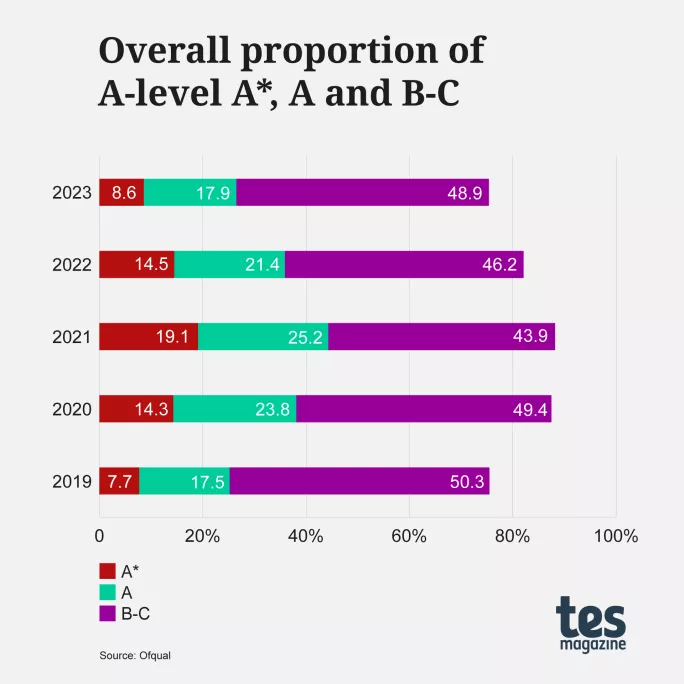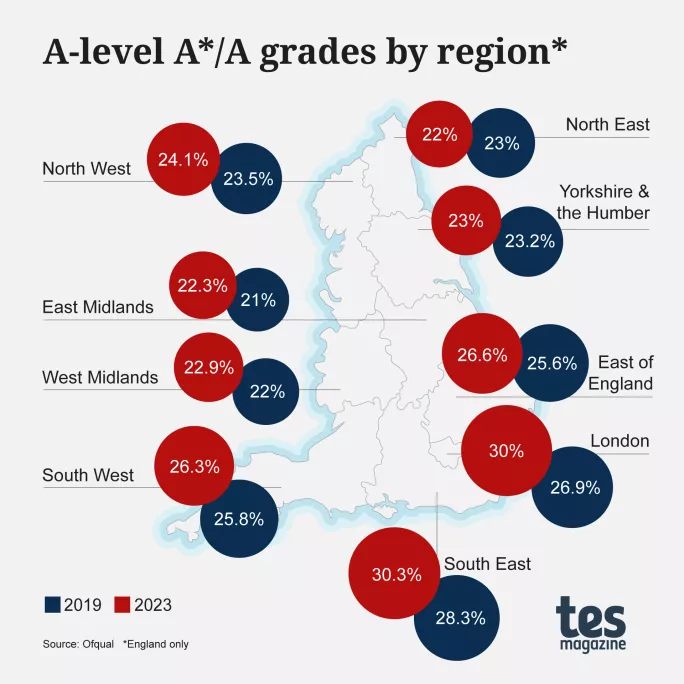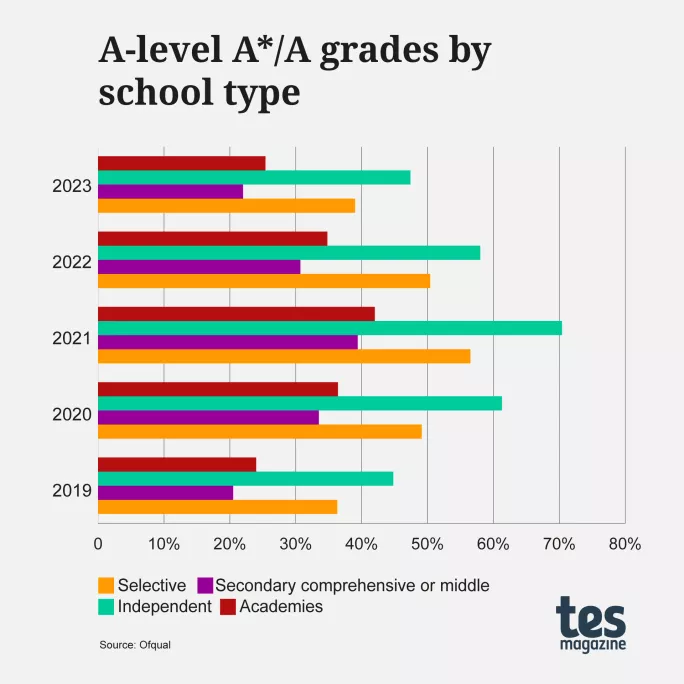A-level results 2023: Top grades up in private schools but drop in North East

A-level results were released across England on Thursday, revealing a stark fall in the number of top grades awarded in the North East compared with pre-pandemic levels.
The results, which reveal an expected fall in the overall proportion of top grades awarded this year, also show a larger rise on pre-pandemic levels in top grades achieved overall at private schools compared with state schools.
This summer, students sat A-level exams for the second year since the pandemic resulted in exams being cancelled in 2020 and 2021.
The government and Ofqual have overseen a return to pre-pandemic grading this year, with “some protection against any impact of Covid disruption”.
There were 67,000 fewer top grades awarded this year than in 2022 and 26,000 more top grades awarded than in 2019.
Here are the headline figures for today’s A-level results.
Not in England? Here’s what you need to know about A-level results around the UK:
- Wales A-level results: Pass rates fall but remain above pre-Covid levels
- A-level passes in Northern Ireland returning to pre-Covid levels
A* grades still up on 2019 levels

Overall, 8.6 per cent of entries received an A*, compared with 14.5 per cent last year, while 26.5 per cent of entries achieved an A or A* grade compared with 35.9 per cent in 2022.
The percentage achieving the top A* grade this year was still above 2019 levels, when 7.7 per cent of entries achieved A* overall.
There was also a drop in the proportion of A*-C grades awarded, with 75.4 per cent of entries achieving these grades compared with 82.1 per cent in 2022. However, figures fell to slightly below 2019 levels, when 75.5 per cent of entries achieved these grades.
The pass rate (A*-E) was also down this year compared with 2022: 97.2 per cent of entries achieved this compared with 98.4 per cent in 2022.
It was also down from the 2019 figure of 97.5 per cent.
See our detailed subject-by-subject breakdown of this year’s A-level results here.
North East top grades lower than in 2019

Last year, the attainment gap in terms of the proportion of A-level exam entries achieving top grades between regions in the North and South of England was wider than when exams were last held before the Covid pandemic.
And this year, a large gap can still be seen between some regions in the North and those in the South, with a lower proportion of top grades achieved in the North East this year (22 per cent) than in 2019 (23 per cent).
The North East was one of two regions whose proportion of A*/A grades was lower than in 2019, the other being Yorkshire and the Humber, where the figure decreased slightly from 23.2 per cent to 23 per cent in 2023.
The gap between the North East, which received the lowest proportion of A* and A grades of all the regions, and the South East, which saw the highest proportion (30.3 per cent), was 8.3 percentage points this year.
This is far higher than the attainment gap between the highest- and lowest-performing regions when A-level exams were last held in 2019, which was 6.3 percentage points.
In 2019, the region with the lowest proportion of A* and As was the West Midlands (22 per cent) and the region with the highest was the South East (28.3 per cent).
Meanwhile, the government highlighted this morning that 60 per cent more students on free school meals gained a place at university this year than did so in 2019.
However, the Sutton Trust has pointed out that the number of students eligible for FSM in English secondary schools increased by 76 per cent between 2018-19 and 2022-23.
Leaders and experts told Tes earlier this month that people were “crossing their fingers and wanting the best for their students” in a year that has been far from “normal”.
The results have led to concerns being raised about the widening regional gap in A-level results and the impact on disadvantaged students.
Geoff Barton, general secretary of the Association of School and College Leaders, said this situation was a consequence of the government’s failure to invest enough money into education catch-up following the Covid pandemic.
And the leader of England’s biggest multi-academy trust has criticised the difference in A-level grading between England, Wales and Northern Ireland.
Sir Jon Coles, chief executive of United Learning, has said that the divergence in the proportion of top grades being achieved in England compared with the other nations was “completely indefensible” and he has urged the government to address this.
Grade gap widens between state and private sectors

In 2022, the proportion of A* and A grades awarded to private school A-level entries fell 12.4 percentage points from 2021 levels, narrowing the gap with the state sector.
However, this year, the proportion of A* and A grades achieved at private schools was 47.4 per cent, which is up 2.6 percentage points on 2019‘s 44.8 per cent.
This percentage-point rise is larger than the rise in the proportion of A*/A grades achieved by comprehensive secondary state school entries: this figure rose from 20.1 in 2019 to 22 per cent this year.
Meanwhile, 25.4 per cent of academy entries and 39 per cent of selective school entries achieved top grades this year, compared with 24 and 37 per cent, respectively, in 2019.
Boys get more A* grades

Girls continued to outperform boys for the fourth year running, with 27 per cent of entries from girls awarded an A grade and above, compared with 26.5 per cent of entries from boys.
However, 8.9 per cent of boys’ entries were awarded an A*, compared with 8.5 per cent of girls’.
And in 2019, the last year before Covid when exams went ahead, 8.1 per cent of entries from boys achieved an A*, compared with 7.3 per cent of entries from girls.
This year, 18.5 per cent of entries from girls achieved an A grade, compared with 22.2 per cent in 2022, while 17.6 per cent of entries from boys achieved an A grade in 2023, down from 20.4 per cent last year.
And 51.1 per cent of girls’ entries achieved a B/C grade this year, compared with 47.2 per cent of boys’.
What A-level students have been through - and what’s next
Those who sat their A levels this summer did not have the chance to sit formal exams at GCSE and were subject to multiple phases of home learning during the pandemic.
Read our report on the disruption that A-level students have suffered here.
With fewer top grades on offer this year, students are being urged to consider alternative options, should they miss out on their first-choice university course.
For those who don’t get the grades required, there are multiple options:
Appealing an A-level grade
The shift in grade boundaries may mean that an increased number of students are left disappointed, and some may wish to appeal against their grade for a given subject.
University clearing
A number of popular universities have also claimed they are already full, meaning that the competition in the clearing process could be particularly fierce in 2023.
Clare Marchant, chief executive of admissions service Ucas, has advised students to be “quick off the mark” when it comes to entering clearing, with there currently being fewer clearing places available than there were at this time last year.
Find out how university clearing works here.
Alternative courses
If a student misses out on the grades required for a particular course, they can phone the university and ask if it would offer a place on a similar/alternative course.
Alternative courses may already appear in the Ucas system as “unconditional course change”. If this is the case, the student usually has five days to research the newly offered course before accepting.
topics in this article



